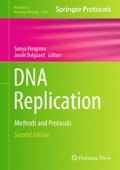Abstract
In order to perform 2-D gel analyses on restriction fragments from higher eukaryotic genomes, it is necessary to remove most of the linear, nonreplicating, fragments from the starting DNA preparation. This is so because the replication intermediates in a single-copy locus constitute such a minute fraction of all of the restriction fragments in a standard DNA preparation—whether isolated from synchronized or asynchronous cultures. Furthermore, the very long DNA strands that characterize higher eukaryotic genomes are inordinately subject to branch migration and shear. We have developed a method that results in significant enrichment of replicating fragments that largely maintain their branched intermediates. The method depends upon two important factors: (1) replicating fragments in higher eukaryotic nuclei appear to be attached to the nuclear matrix in a supercoiled fashion, and (2) partially single-stranded fragments (e.g., those containing replication forks) are selectively adsorbed to benzoylated naphthoylated DEAE (BND)-cellulose in high salt concentrations. By combining matrix-enrichment and BND-cellulose chromatography, it is possible to obtain preparations that are enriched as much as 200-fold over the starting genomic DNA, and are thus suitable for analysis on 2-D gels.
Access this chapter
Tax calculation will be finalised at checkout
Purchases are for personal use only
References
Nawotka KA, Huberman JA (1988) Two-dimensional gel electrophoretic method for mapping DNA replicons. Mol Cell Biol 8:1408–1413
Brewer BJ, Fangman WL (1987) The localization of replication origins on ARS plasmids in S. cerevisiae. Cell 51:463–471
Benard M, Pierron G (1992) Mapping of a Physarum chromosomal origin of replication tightly linked to a developmentally-regulated profilin gene. Nucleic Acids Res 20:3309–3315
Heck MM, Spradling AC (1990) Multiple replication origins are used during Drosophila chorion gene amplification. J Cell Biol 110:903–914
Pienta KJ, Getzenberg RH, Coffey DS (1991) Cell structure and DNA organization. Crit Rev Eukaryot Gene Expr 1:355–385
Cook PR, Brazell IA, Jost E (1976) Characterization of nuclear structures containing superhelical DNA. J Cell Sci 22:303–324
Mirkovitch J, Mirault ME, Laemmli UK (1984) Organization of the higher-order chromatin loop: specific DNA attachment sites on nuclear scaffold. Cell 39:223–232
Dijkwel PA, Mullenders LH, Wanka F (1979) Analysis of the attachment of and replicating DNA to a nuclear matrix in mammalian interphase nuclei. Nucleic Acids Res 6:219–230
Vaughn JP, Dijkwel PA, Mullenders LH, Hamlin JL (1990) Replication forks are associated with the nuclear matrix. Nucleic Acids Res 18:1965–1969
Levine AJ, Kang HS, Billheimer FE (1970) DNA replication in SV40-infected cells. I. Analysis of replicating SV40 DNA. J Mol Biol 50:549–568
Hamlin JL, Dijkwel PA, Vaughn JP (1992) Initiation of replication in the Chinese hamster dihydrofolate reductase domain. Chromosoma 102:17–23
Dijkwel PA, Mesner LD, Levenson VV, d’Anna J, Hamlin JL (2000) Dispersive initiation of replication in the Chinese hamster rhodopsin locus. Exp Cell Res 256:150–157
Mesner LD, Crawford EL, Hamlin JL (2006) Isolating apparently pure libraries of replication origins from complex genomes. Mol Cell 21:719–726
Zhou J, Ermakova OV, Riblet R, Birshtein BK, Schildkraut CL (2002) Replication and subnuclear location dynamics of the immunoglobulin heavy-chain locus in B-lineage cells. Mol Cell Biol 22:4876–4889
Vassilev LT, Johnson EM (1990) An initiation zone of chromosomal DNA replication located upstream of the c-myc gene in proliferating HeLa cells. Mol Cell Biol 10:4899–4904
Giacca M, Zentilin L, Norio P, Diviacco S, Dimitrova D, Contreas G, Biamonti G, Perini G, Weighardt F, Riva S (1994) Fine mapping of a replication origin of human DNA. Proc Natl Acad Sci U S A 91:7119–7123
Dijkwel PA, Vaughn JP, Hamlin JL (1991) Mapping of replication initiation sites in mammalian genomes by two-dimensional gel analysis: stabilization and enrichment of replication intermediates by isolation on the nuclear matrix. Mol Cell Biol 11:3850–3859
Feinberg AP, Vogelstein B (1983) High specific activity labeling of DNA restriction fragments. Anal Biochem 132:6–13
Mosca PJ, Dijkwel PA, Hamlin JL (1992) The plant amino acid mimosine may inhibit initiation at origins of replication in Chinese hamster cells [published erratum appears in Mol Cell Biol 1993, 13:1981]. Mol Cell Biol 12:4375–4383
Labarca C, Paigen K (1980) A simple, rapid, and sensitive DNA assay procedure. Anal Biochem 102:344–352
Reed KC, Mann DA (1985) Rapid transfer of DNA from agarose gels to nylon membranes. Nucleic Acids Res 13:7207–7221
Vaughn JP, Dijkwel PA, Hamlin JL (1990) Replication initiates in a broad zone in the amplified CHO dihydrofolate reductase domain. Cell 61:1075–1087
Little RD, Platt TH, Schildkraut CL (1993) Initiation and termination of DNA replication in human rRNA genes. Mol Cell Biol 13:6600–6613
Braunstein JD, Schulze D, DelGiudice T, Furst A, Schildkraut CL (1982) The temporal order of replication of murine immunoglobulin heavy chain constant region sequences corresponds to their linear order in the genome. Nucleic Acids Res 10:6887–6902
Acknowledgments
We thank the present and former members of our laboratory for very helpful discussions. This work was supported by a grant from the NIH to J.L.H. and L.D.M. (RO1 GM26108).
Author information
Authors and Affiliations
Corresponding author
Editor information
Editors and Affiliations
Rights and permissions
Copyright information
© 2015 Springer Science+Business Media New York
About this protocol
Cite this protocol
Mesner, L.D., Dijkwel, P.A., Hamlin, J.L. (2015). Purification of Restriction Fragments Containing Replication Intermediates from Complex Genomes for 2-D Gel Analysis. In: Vengrova, S., Dalgaard, J. (eds) DNA Replication. Methods in Molecular Biology, vol 1300. Humana Press, New York, NY. https://doi.org/10.1007/978-1-4939-2596-4_16
Download citation
DOI: https://doi.org/10.1007/978-1-4939-2596-4_16
Publisher Name: Humana Press, New York, NY
Print ISBN: 978-1-4939-2595-7
Online ISBN: 978-1-4939-2596-4
eBook Packages: Springer Protocols

